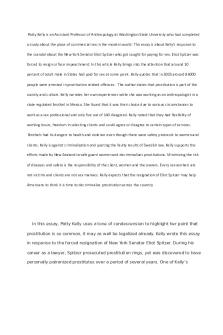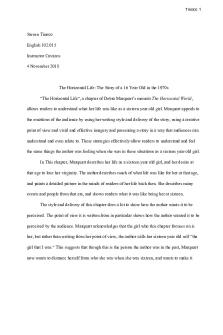Rhetorical analysis part 1 PDF

| Title | Rhetorical analysis part 1 |
|---|---|
| Course | English 103 |
| Institution | MacEwan University |
| Pages | 3 |
| File Size | 56.7 KB |
| File Type | |
| Total Downloads | 85 |
| Total Views | 131 |
Summary
Rhetorical analysis...
Description
Adam Muhareb Professor Hutchinson ENGL 102 31 October 2020 Rhetorical analysis allows us to breakdown reading material into multiple parts in order to give the reader a more thorough understanding of what the author is trying to illustrate to the reader. In this essay, three literary works will be analyzed. These works come in the form of letters; Martin Luther King, Jr. “Letter from Birmingham Jail”, Chief Seattle: “Letter to President Pierce”, and Lady Mary Wortley Montagu “Letter to the Countess of Bute, Lady Montagu’s Daughter”. To briefly summarize, Martin Luther King, Jr’s. “Letter from Birmingham Jail” was a response to the clergymen (religious leaders) who had criticized him for conducting a non-violent protest in Birmingham, Alabama. The letter was written after King was arrested for protesting. Chief Seattle: “Letter to President Pierce” is a letter that is shifted towards persuading European men (white men) to recognize and understand the natives’ objection to their selfish Excellent acts. The Lady Mary Wortley Montagu “Letter to the Countess of Bute, Lady Montagu’s Daughter” expresses Montagu’s personal beliefs of women's right to a proper education. In order to persuade their opposers, all three letters apply the rhetorical devices of pathos and ethos to establish their arguments. Pathos is just one of the four rhetorical devices used in all three letters, it is defined by utilizing the appeal of emotion in order to persuade their reader. In the “Letter from Birmingham Jail” , Martin Luther King, Jr. uses pathos effectively by thoroughly illustrating what African Americans endure everyday just because of their skin colour. For example, he talks about how mothers and fathers are lynched and siblings are drowned because white men felt like it. Chief Seattle: “Letter to President Pierce” uses pathos by giving the white men a real understanding of why their carelessness will have detrimental effects on nature; Chief Seattle desires to make them more appreciative of nature. Evidence of this would be when Chief Seattle asks “Where is the thicket? Gone. Where is the eagle? Gone.”(529) The use of these questions intends to elicit a feeling of guilt in the white men. In the “Letter to the Countess of Bute, Lady Montagu’s Daughter” by Lady Mary Wortley Montagu utilizes pathos by describing her personal references on the situation. An example of this would be when she talks about when a friend of hers received a love letter from a man and as Lady Montagu was reading it she noticed the verses were plagiarized from another poem. These examples clearly show how emotion (pathos) is used in a persuasive manner. Ethos is another rhetorical device that is utilized throughout all three letters. Ethos is defined by using the appeal of ethics in order to convince their reader into their favour. Martin Luther King Jr. uses ethos by advocating for civil rights, but more specifically by
ensuring his morality, trustworthiness, and believability to his audience. For example, he writes “One may well ask: ‘How can you advocate breaking some laws and obeying others?” The answer lies in the fact that there are two types of laws: just and unjust”. (208). In the “Letter to President Pierce” written by Chief Seattle, the Chief uses ethos by writing “What Chief Seatlle says you can count on as truly as our white brothers can count on the return of the seasons. My words are like stars -- they do not set.” His main point in the use of the simile is to depict his honesty and to gain trust from President Pierce and the white man. The letter by Lady Montagu uses ethos by referencing Waller when explaining how many verses have been stolen from him resulting in the woman thinking they are originals. She claims that if women were to be properly educated they would not be taken advantage of like this. The following examples show how all three letters used ethos effectively in order to persuade the oppressor. In conclusion, all three letters apply the rhetorical devices of pathos and ethos to establish their arguments in order to persuade the opposition. The use of pathos and ethos illustrates the main points of their arguments in a very effective and convincing way. The utilization of emotion in an argument is very powerful and something a great speaker always does. Using Ethical reasoning in an argument is a very constructive way to get a point across. Rhetorical devices in these 3 letters help the reader thoroughly understand where each argument is coming from and have a high-level of understanding for it.
Works Cited Cedars, S.R.. McKeever, Christine ed. "Letter From Birmingham Jail Summary". GradeSaver, 30 July 2014 Web. 3 November 2020. "Rhetorical Devices Used in “Letter from Birmingham Jail”." ukessays.com. 11 2018. UKEssays. 11 2020 . “Rhetorical Analysis of Chief Seattle Letter.” SparkXL, 19 Jan. 2018, www.sparkxl.com/2018/01/19/rhetorical-analysis-of-chief-seattle-letter/. “Lady Mary Wortley Montagu Rhetorical Analysis” Study Moose, 9 April 2016, https://studymoose.com/lady-mary-wortley-montagu-rhetorical-analysis-essay...
Similar Free PDFs

Rhetorical analysis part 1
- 3 Pages

Rhetorical analysis -1
- 4 Pages

Rhetorical Analysis
- 5 Pages

Rhetorical analysis
- 2 Pages

Rhetorical analysiis part 2
- 4 Pages

Puppy Rhetorical Analysis
- 4 Pages

Bowling Dana Rhetorical Analysis
- 4 Pages

Rhetorical Analysis Essay
- 5 Pages

Textual Rhetorical Analysis
- 3 Pages

Rhetorical Analysis Final
- 5 Pages

Rhetorical Analysis Prompt
- 2 Pages

Final Rhetorical Analysis Essay
- 2 Pages

Rhetorical analysis pt1
- 2 Pages
Popular Institutions
- Tinajero National High School - Annex
- Politeknik Caltex Riau
- Yokohama City University
- SGT University
- University of Al-Qadisiyah
- Divine Word College of Vigan
- Techniek College Rotterdam
- Universidade de Santiago
- Universiti Teknologi MARA Cawangan Johor Kampus Pasir Gudang
- Poltekkes Kemenkes Yogyakarta
- Baguio City National High School
- Colegio san marcos
- preparatoria uno
- Centro de Bachillerato Tecnológico Industrial y de Servicios No. 107
- Dalian Maritime University
- Quang Trung Secondary School
- Colegio Tecnológico en Informática
- Corporación Regional de Educación Superior
- Grupo CEDVA
- Dar Al Uloom University
- Centro de Estudios Preuniversitarios de la Universidad Nacional de Ingeniería
- 上智大学
- Aakash International School, Nuna Majara
- San Felipe Neri Catholic School
- Kang Chiao International School - New Taipei City
- Misamis Occidental National High School
- Institución Educativa Escuela Normal Juan Ladrilleros
- Kolehiyo ng Pantukan
- Batanes State College
- Instituto Continental
- Sekolah Menengah Kejuruan Kesehatan Kaltara (Tarakan)
- Colegio de La Inmaculada Concepcion - Cebu


